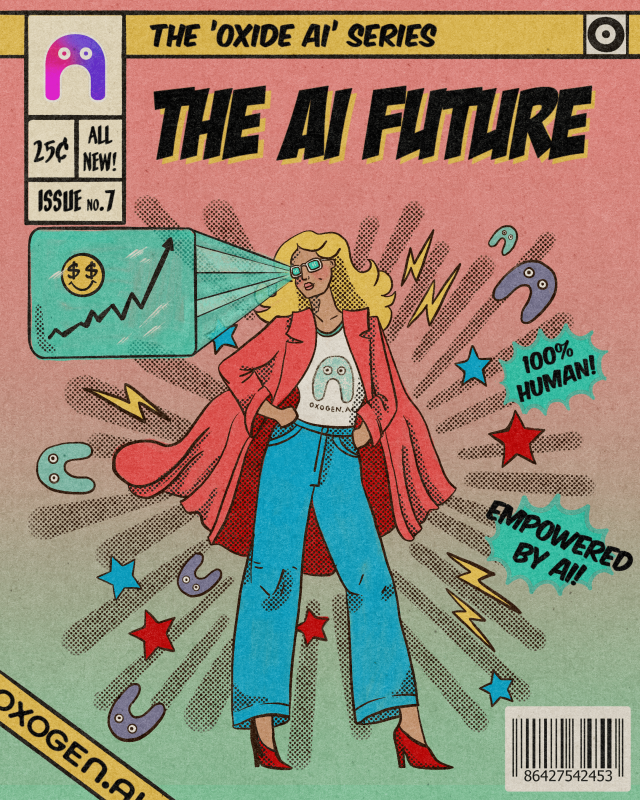
Learn how we can amplify humans with AI
We inhabit an era saturated with data. Every day, the volume of information grows faster than any human mind can track, let alone understand. The cognitive burden is immense, overwhelming even the most disciplined human attention.
Consider the financial markets: news reports, earnings filings, analyst notes — an endless stream floods investors every hour. For a single investor, or even an entire team, combing through data on thousands of public companies to find a few gleaming insights isn’t just impractical; it’s impossible. It would take years to do what the market demands by nightfall. And tomorrow, it begins anew.
The question isn’t whether we can keep up. We can’t. The financial information storm breeds confusion, decision fatigue, and, inevitably, delegation. We seek refuge in abstraction: index funds like ETFs, algorithmic trading, or outsourced advice, because the raw data is too vast to navigate alone. And somewhere along the way, the slow, imperfect work of being human begins to fade.
Enter Generative Artificial Intelligence
Initially perceived as a tool to help navigate complexity, generative AI now threatens to amplify the information overload exponentially. The velocity and volume of content creation are set to explode. But this acceleration comes with a serious caveat: inherent probabilistic inaccuracies. Current Generative AI models operate within accuracy ranges often cited between 60% and 90%.
Impressive, but not foolproof. And in a system that increasingly feeds itself, even small errors don’t just accumulate, they cascade. As AI systems rely more heavily on AI-generated content for training and output, we face the growing risk of compounding error, a phenomenon that could quietly erode informational integrity over time.
Generative AI models also face a structural limitation: they are trained on the past while the world keeps moving. To generalize, they reduce entropy, smoothing out complexity but erasing critical variation along the way. Some newer systems try to fix this by incorporating fresh web data using so-called “deep research” models that search and rank sources dynamically. But adding more data does not always mean adding more truth. The biases baked into search algorithms and the uneven quality of the selected online sources creep into the results, dressed up as insights. Rather than offering a clear window into the real-time market, these models often reinforce pre-existing distortions under the appearance of freshness.
The Counter-Reaction: The Quest for Quality
This escalating information noise, paradoxically fueled by AI itself, sparks a powerful countertrend: an accelerating demand for the minimal and the relevant. As the volume swells and baseline quality becomes questionable, a premium will be placed on truth and concision. We will see a gravitation toward rigorously validated, authoritative sources, those we can trust not only to inform but to guide us. Sophisticated aggregation and verification systems, potentially AI-powered, but focused on quality control rather than pure generation, will emerge as indispensable gatekeepers. In this new information economy, trust and accuracy will be the currencies we can no longer afford to overlook.
The initial fascination with AI’s ability to generate extensive outputs — a 50-page report drafted in minutes, a comprehensive presentation whipped up instantly — is likely to be short-lived. Why? Because human attention is finite and precious. No one has the bandwidth to consume endless streams of AI-generated verbosity, especially when its reliability is uncertain. It’s the same old story: we’re promised the world, but we can’t keep up. So what happens next? The inevitable move toward summarization. This, of course, only adds another layer of potential distortion, selection bias, and error accumulation, further highlighting the diminishing returns of bulk generation.
The explosion of chatbots, once a novelty, may soon lead to interaction fatigue. Imagine a world populated by millions of automated conversational agents, all interacting with each other, but never with us. What’s left? The diminishing value of a single, meaningful conversation.
The Interface Revolution: An Imperative for Precision
Perhaps the most compelling driver toward minimalism is the evolution of our digital interfaces, increasingly mediated by AI. We are moving beyond the screen-centric paradigms of desktops and smartphones, inching closer to a world where technology quietly blends into the background of our lives. AI is making this shift possible, driving the practical integration of ambient computing: intelligent Head-Up Displays (HUDs) in vehicles, AI-infused smartwatches, AI headphones, and eventually, the mainstream arrival of Augmented Reality (AR) eyewear, the much-anticipated AI Glasses.

These emerging platforms demand radically different interaction models. Displaying dense paragraphs of text or complex data visualizations on a car’s windshield or inside AR glasses is not just impractical; it’s irrelevant and distracting. Information delivered through these channels must be distilled to its absolute essence: minimal, contextually relevant, and instantly actionable. The tolerance for superfluous data collapses.
As a result, the requirements for precision and accuracy will skyrocket. It is no longer enough for information to be broadly correct. It must be exactly the right piece of information, delivered at exactly the right time, in exactly the right way.
The trajectory appears clear. While Generative AI may add to the overwhelming noise in its early stages, its long-term impact, combined with evolving hardware and the unchanging limits of human cognition, will force a profound recalibration. We are being propelled toward an information ecosystem where value lies not in volume, but in validated relevance and minimalist precision.
The future of AI belongs not to those who generate the most information, but to those who can uncover the signal worth hearing. In the end, it is not about outpacing human limits. It is about honouring them. This is where Oxide AI draws the line: amplifying humans, not overwhelming them.
